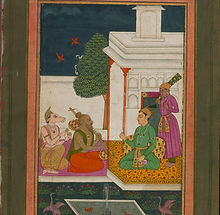Jhala
The concluding segment of the Alapa unfolds at a relatively brisk pace, employing a specific type of Ṥabdālaṁkāra, known as Jhala. In stringed instruments such as Sitar, Surbahar, Sarod, and Rudra Vina (Veena), there is a continuous stimulation of the Cikārī, aimed at generating a rhythmic drone that alternates with a melody created on the main strings.
The presentation of the melodic motif is gradual, even though the rhythm intensifies during this phase. The rhythmic possibilities are myriad, constituting a fundamental aspect of instrumental expression.
The rhythm can be structured as follows:
- 4+4 = Da c c c Da c c c
- 3+3+2 = Da c c Da c c Da c
- 3+2+3 = Da c c Da c Da c c
- 2+3+3 = Da c Da c c Da c c
- 3+3+3+3+4 = Da c c Da c c Da c c Da c c Da c c c
- 2+3+2+3+3+3 = Da c Da c c Da c Da c c Da c c Da c c
- 3+3+4+3+3 = Da c c Da c c Da c c c Da c c Da c c
Layakari, rhythmic variations, can also be expressed by playing with the regular beat of four:
- in 5 = Da c Da c c
- in 6 = Da c c Da c c
- in 7 = Da c c Da c c c
The preferred structure involves two or three bars in a regular form and two or one with Layakari:
Da c c c | Da c c c | Da c c c | Da c Da c c |
The fundamental Bola of the Jhālā comprises Ḍā on the melodic string and Rā (c) on the Cikārī, where the combination of four strokes, for example, |ḌāRāRāRā| or |Da c c c|, forms a time unit of four Matras.
Singers emulate this purely instrumental Sabdalamkara with Bola TāNāNāNā or DeReNaTa or even incorporate Mantras such as |HariOmNarayana| within a melody.
Although the phases leading to the Jhala involve both singers and musicians, this phase is distinctly instrumental. There are instances of singers imitating specific rhythmic effects with their voices.
From this point onward, the rhythmic dimension of the Ālāpa becomes overtly explicit. Occasionally, musicians introduce this part directly from the 'Madhya-Druta.' Jhālā is an onomatopoeic term, mirroring the sound produced by the Cikārī. The drone created by three strings, tuned to Pa, the central Sa, and the upper octave's Sa, serves as a backdrop to the Rāga's exposition.
The plectrum or Mizrab swiftly traverses between the Cikārī and the string capable of producing the melody, alternating in various rhythmic combinations. At times, percussion instruments commence accompanying the instrument during this phase, although this usually occurs only in the Laḍī phase.
INDIAN CLASSICAL MUSIC LESSONS AND ONLINE COURSES
IN MODAL MUSIC, IMPROVISATION AND COMPOSITION
LEARN THE MAIN TECHNIQUES OF INDIAN MUSIC WITH A SIMPLE AND PERSONALIZED METHOD!
My online music lessons are the perfect way to learn to sing, or improve the vocal techniques already acquired, or to start playing your favorite instrument or progress in your musical path through an alternative teaching method to Western teaching.
The goal of my Indian classical music courses is to teach you the basics of this wonderful art form. You will learn about the various Ragas, or modal scales, the Talas or rhythmic cycles, and the vocal and instrumental techniques used for improvisation in Indian classical music.
What makes my approach to teaching indian classical music so distinctive?
My teaching system is obviously unique and different from others and I think that learning music following the traditional Indian approach is the most effective method regardless of genre: pop, jazz, world fusion, electronic, whatever musical style you if you are interested, I guarantee that thanks to the Indian perspective, you will have an edge over all the other musicians.
What will you learn?
During my lessons I use a variety of techniques and exercises to learn to improvise and compose. What you will learn in my Indian classical music courses will be based on the concepts of modal scale and rhythmic cycle, i.e. Raga and Tala. You will also learn vocal and instrumental techniques which, although based on Indian musical theory, also find application in the Western musical system.
Will the course suit you?
My courses are aimed to all musicians of all levels, beginners, intermediate and advanced, offering different study materials and techniques from the usual Western standards. All those who want to learn to play Indian classical music are welcome and no previous knowledge or experience is necessary to get started.
I can not wait to get to know you!
Contact me now! The first lesson is FREE!











%2018th-19th%20centuries%20b.jpg)




